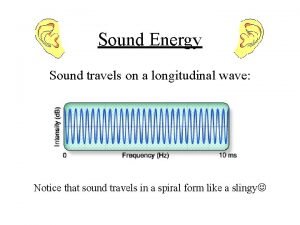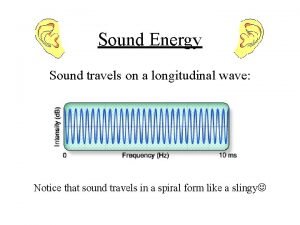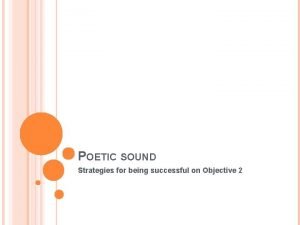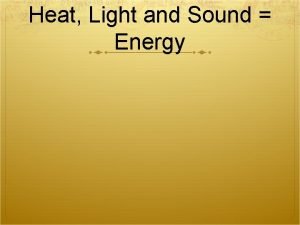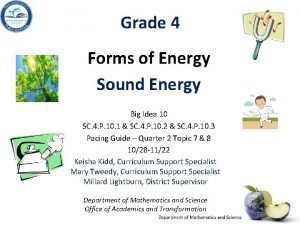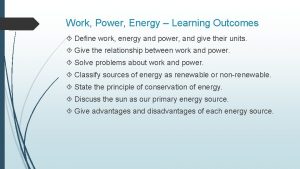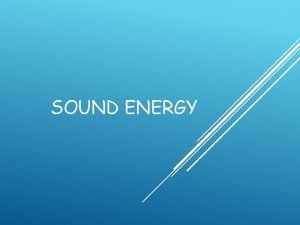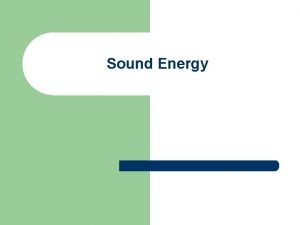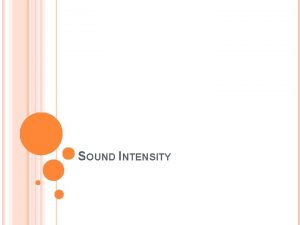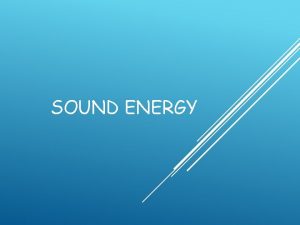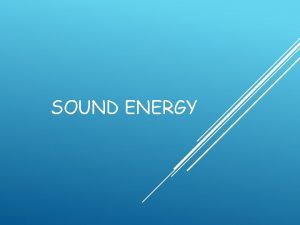SOUND ENERGY WHAT IS SOUND Sound is a










- Slides: 10

SOUND ENERGY

WHAT IS SOUND? Sound is a form of energy that can be heard and travels in longitudinal waves. When matter vibrates or moves back and forth very quickly, a sound is made. Sound waves can ONLY travel through a medium: solids, liquids, or gases. Example: When a school bell rings, parts of the bell will vibrate, creating a sound.

d n Sou s e v a W Sound A is a kind of energy that can be heard. sound is made when things vibrate. Sound travels in waves. Sound must travel through matter (a medium) to be heard. The vibrating object makes the matter around it vibrate, too. Sound vibrations move through the air into your ears and make the eardrums vibrate. Volume is how loud or soft a sound is- AMPLITUDE. Pitch is how high or low a sound is- WAVELENGTH.

SOUND TRAVELS THROUGH MATTER Solids Ø Ø Ø Some sounds that we hear travel through solids. Sound waves travel very fast through solids. For example: if you put your ear against the desk and someone else hits the desk, the sound travels to your ear through the solid-your desk. Liquids Gases Some sounds that Most of the we hear travel sounds we hear through water. travel through gases, such as air. Ø Sound waves travel a faster through Sound waves water than through travel slowly the air. through the air. Ø Sonar is the way to For example: use sounds to locate Sound from a bell, objects under water. a horn, or an alarm clock travels through the air. What animals use sonar? Ø

PITCH Pitch is the high or low sound an object makes. Objects that vibrate slowly, make a low pitch. Example-drum. Objects that vibrate quickly, make a higher pitch. Examplerecorder ………. . …………. . . . ………. . . . . …………. . . ………. . …………. . . . ………… ………… . . . . …………… …………… …………… . . . . The wave on top has a higher pitch than the wave on the bottom because the wave on top has a shorter wavelength, or distance between compressions. . .

LOUDNESS OR VOLUME Volume is the loudness or the softness of a sound. Loud sounds have a lot of energy. Soft sounds use a little energy. Example: The harder a drum is hit, the more the drum will vibrate. The more an object vibrates, the louder the sound it makes. IIIIIIII I I IIII I I IIIIIIII I I I IIII I IIII The top wave has a higher amplitude, and thus, more volume. The bottom wave has a shorter amplitude, and thus, less volume.

HOW DOES SOUND TRAVEL? Sound passes through the medium as longitudinal waves. When the vibrations are fast you hear a high pitch. When they’re slow, you hear a low pitch. High Pitch Low Pitch

HOW YOU MAKE SOUNDS We use our vocal cords to make sounds in our throat. When we speak, our vocal cords vibrate. Place your hand on your throat when you talk, and you can feel the vocal cords vibrate.

How does the ear work? ¡ ¡ Sound waves are sent. The outer ear “catches the sound waves”. The middle ear takes the sound waves and “vibrates” the eardrum. The inner ear sends the messages to the brain. Middle Ear Outer Ear Sound Waves ¡ Inner Ear The brain puts it together and hooray! You hear your favorite song on the radio.

DID YOU KNOW? Sound travels 4 times faster through water than through air. There is no sound in space. Geologists use their knowledge of how sound travels through rocks to help them find oil fields.
 Energy energy transfer and general energy analysis
Energy energy transfer and general energy analysis Energy energy transfer and general energy analysis
Energy energy transfer and general energy analysis “a sound mind is in a sound body”
“a sound mind is in a sound body” Loud sound and soft sound
Loud sound and soft sound Sound energy
Sound energy Spund energy
Spund energy Puget sound energy investor relations
Puget sound energy investor relations Enjambment effect
Enjambment effect Heat light and sound energy
Heat light and sound energy Sound energy grade 4
Sound energy grade 4 Learning outcomes of work and energy
Learning outcomes of work and energy




